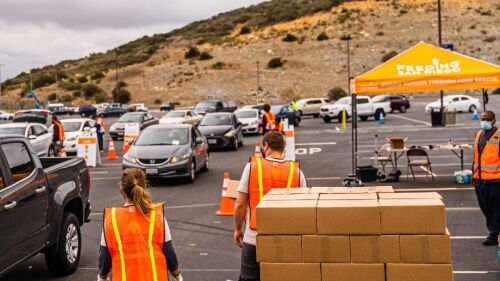The San Diego Natural History Museum — aka The Nat — celebrated its 150th anniversary in 2024 with special events and new additions.
As a longtime rock for the research and understanding of our region’s one-of-a-kind biodiversity, the museum’s roots are deeply intertwined with the curious scientists and naturalists who helped shape its history. Our friends at the museum invited us into their library archives to unearth the stories of six incredible local women who helped shape The Nat. These are their stories.
Ellen Browning Scripps | (1836-1932)
Fast facts:
- San Diegans know Ellen Browning Scripps for her philanthropy that helped establish many local health care, educational, and cultural institutions — including Scripps Memorial Hospital and Scripps Institution of Oceanography.
- Originally from England, Browning Scripps moved to the US and became one of the first women to attend college, graduating from Knox College in Illinois in 1858.
- She worked as a teacher (for a monthly salary of $9) before embarking on a long journalism career.
- Her family — including her brother E.W. Scripps — built a longtime, far-reaching newspaper empire, leading them to achieve great wealth.
- Browning Scripps moved to La Jolla in 1896 and began investing in the community through philanthropy, including giving her support to the San Diego Natural History Society — the group that would eventually form the San Diego Natural History Museum.
- On Feb. 22, 1926 — at age 89 — Browning Scripps was on the cover of “TIME” Magazine.
Wise words:
- Local headlines dubbed the generous Browning Scripps “the most beloved woman in Southern California.”
- “The most important and beautiful gift one human can give to another is, in some way, to make life a little better to live,” Scripps said of her philanthropy in 1924.
- When she died in La Jolla in 1932, her obituary headline read: “San Diego’s Most Useful Citizen.”
Kate Sessions | (1857-1940)
Fast facts:
- The legacy of the famed botanist and horticulturist can be seen all around San Diego.
- She graduated from University of California Berkeley in 1881 — The Nat’s archives house some of the notes she took in class as a college student.
- Born in Oakland, CA, Sessions moved to San Diego in 1884. She started a plant nursery in 1892, and contracted with the city to plant 100 trees annually for the next 10 years.
- Sessions grew nurseries in Coronado, Pacific Beach, and Mission Hills — including Mission Hills Nursery, still operating to this day.
- She introduced exotic trees like the jacaranda, bougainvillea, and bird of paradise to the region, plus rare palms she collected from a trip to Los Cabos, Mexico, in 1902.
Wise words:
- Sessions was dubbed the “Mother of Balboa Park” — the landmark she helped plan with proposals for a “City Park” in the area dating back to 1891.

Kate Stephens, during one of her research trips into the field.
Photo via San Diego Natural History Museum
Katherine “Kate” Stephens | (1853-1954)
Fast facts:
- Kate Stephens — one of the first female curators in the US — is known as The Nat’s “Founding Mother.”
- She became a nationally recognized naturalist and paleontologist.
- Originally from England, she came to San Diego County in 1890 to stay with her cousin in Witch Creek. She quickly became interested in the shells of San Diego County.
- She married Frank Stephens in 1898.
- In 1910, she became the first Curator of Collections for the San Diego Society of Natural History — the society’s first-ever paid employee.
- Kate and Frank Stephens collaborated to create original exhibitions for the museum.
- They traveled together on all collecting expeditions; Frank Stephens’ hearing was bad and he was a bad driver, so Kate Stephens took the reins.
- Kate Stephens cataloged shell collections and collected new specimens, including 200 shells of 100+ species from North Coronado Island.
- She retired in 1936 and, at the time, had the longest service of all museum staff.
Wise words:
- According to a September 1934 article in the “San Diego Union,” Kate Stephens was known as “an authority on shells, both recent and fossil.”
- Many say that if not for the devotion of Kate and Frank Stephens, The Nat wouldn’t be what it is today.
- Did you know? The Nat has copies of Kate Stephens’ field notes from the early 1900s, chronicling her desert trips around San Diego and Imperial counties. We can confirm — she is meticulous and detailed with every word.

Rosa Smith Eigenmann was the first woman to become a full member of the San Diego Society of Natural History.
Photo via San Diego Natural History Museum
Rosa Smith Eigenmann | (1858-1947)
Fast facts:
- Rosa Smith Eigenmann was the first professional female ichthyologist — someone who studies fish.
- Born in Illinois, she moved with her family to San Diego in 1876 and became interested in local natural history.
- Eigenmann was the first woman to become a full member of the San Diego Society of Natural History.
- She was also the society’s first-ever librarian.
- During her research, she wrote about a fish discovered in Point Loma — the Blind Goby, and published a paper in 1881; she was the first person to describe the fish for science.
- She met Carl Eigenmann — another researcher — and they wed in 1887.
- The couple had five kids, retired in Coronado in 1926, and lived there until their deaths.
Wise words:
- Rosa Smith Eigenmann published 12 scientific papers as a single author.
- Rosa and her husband published 25 papers together detailing 150 species of fish — and their byline was, naturally, “Eigenmann + Eigenmann.”

Margaret Wood Bancroft wore many hats — and always loved exploring and the great outdoors.
Photo via San Diego Natural History Museum
Margaret Wood Bancroft | (1893-1986)
Fast facts:
- Margaret Wood Bancroft was born in Kentucky and was one of eight children.
- The Wood family moved to San Diego in 1900, to a house at Cedar and Third streets.
- When her parents drove the family out to La Jolla after their move, it was the first time any of them had ever seen the ocean.
- They relocated to Descanso in 1902, and liked the mountain life in San Diego County.
- The family purchased Witch Creek Ranch, a 15-acre guest ranch with a hotel that they ran as a business.
- Kate Sessions once stayed at the ranch; she showed Margaret and her sisters how to box and ship the English lilacs that grew in the area for sale.
- Bancroft was skilled at riding horses and her friends talked her into joining their movie studio. She became a silent actress and stunt person for cowboy movies, and even worked for the studio of “Birth of a Nation” director D.W. Griffith.
- She eventually married Griffing Bancroft, became a stepmother to his sons, and they lived a high society life in San Diego.
- In her life as a homemaker, socialite, and explorer, Wood Bancroft would accompany her husband on egg collecting expeditions.
- The couple moved to La Jolla in 1946.
Wise words:
- When the Wood family first moved to San Diego, Margaret’s parents drove her and her siblings to La Jolla. It was the first time any of them had ever seen the ocean, and this is how she described it, “It was the most exciting day and it’s vivid in my mind, all of us coming back, just dripping with shells and everything we could collect.”
- Did you know? The Nat’s Research Library houses a collection of Bancroft’s personal scrapbooks, letters, writings, and photographs detailing her explorations in Baja California.

Dubbed San Diego’s “No. 1 career girl,” Ethel Bailey Higgins asked to retire from The Nat on her 96th birthday. She had worked there for 30 years.
Photo via San Diego Natural History Museum
Ethel Bailey Higgins | (1866-1963)
Fast facts:
- Born in Maine, Ethel Bailey Higgins developed an early interest in flowers.
- She moved to California in 1900, and was intrigued by the flowers of the region.
- In Hollywood, she developed a talent for flower photography, producing 30 plant portraits. To identify the subjects in her photos, she took up botany. Her photography work was lucrative for many years.
- She married John C. Higgins in 1914.
- Bailey Higgins exhibited her high-quality, hand-tinted photos at the 1915 Panama-California Exposition at Balboa Park.
- In 1933, she became a full-time botanist and joined the San Diego Natural History Museum’s staff; in 1943, she became the Curator of Botany until 1957. She was the Associate Curator from 1957 to 1963.
- Bailey Higgins set off on collecting trips and added 196 plant species to the museum’s collections, and established the first accession record of plants held in the museum’s herbarium. During her time at the museum, the size of the botany department’s herbarium grew from 6,000 to 46,000 specimens.
- She helped expand the museum’s educational reach in San Diego.
Wise words:
- Did you know? The Nat museum houses Ethel Bailey Higgins’ brown, spiral notebooks of numbered specimen lists.
- Dubbed San Diego’s “No. 1 career girl,” she asked to retire from the museum on her 96th birthday. She had worked there for 30 years.
- According to The Nat, Bailey Higgins was known for her great sense of humor — like the time she joked with the local press about how the police had found every specimen of marijuana she tried to collect first for the herbarium.
Pro tip: Elements of some of these womens’ stories — like the life of Bailey Higgins — can be seen in the museum’s permanent exhibition, “Extraordinary Ideas from Ordinary People: A History of Citizen Science.” You can also see historic photographs in the museum’s “Action from the Archives: The Nat at 150" exhibition.
The Nat is open daily, 10 a.m.-5 p.m.













